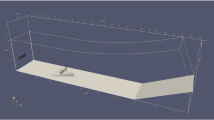Abstract
Interest in the development of micro vortex generators (MVGs) to control high-speed flow separation has grown in the last decade. In contrast to conventional vortex generators, MVGs are fully submerged in the boundary layer and have the potential of inducing surface flow mixing with marginal drag penalty when suitably designed. Also, they do not result in undesired reduced mass flow such as with suction methods. The flow mechanisms at the location of MVGs are not yet fully understood, and optimal designs are difficult to establish given that both numerical predictions and experiments are particularly challenged for short element heights, yet optimal MVGs are generally expected to be at least shorter than half the local boundary layer thickness. The present work aims at investigating experimentally the fundamental flow physics concerning an individual MVG element (of ‘canonical’ or simplified geometry) at a range of near-wall heights. A fully laminar base flow is considered so as to isolate the effect of incoming turbulence as well as the more complex physics that may occur when specific and/or multiple elements are used. Tests were performed in a gun tunnel at a freestream Mach number of 8.9 and Reynolds number of \(47.4\times 10^{6}\)/m, and the basic test model consisted of a blunt-nosed cylinder which produced an axisymmetric laminar boundary layer with an edge Mach number of 3.4 and Reynolds number of \(3.2\times 10^{6}\)/m at the MVG location. A laminar shock-wave/boundary layer interaction with separation was induced by a flare located further downstream on the model. Measurements consisted of time-resolved surface heat transfer obtained in the axial direction immediately downstream of the MVG and along the interaction, together with simultaneous high-speed schlieren imaging. The height (\(h\)) of the MVG element used in a ‘diamond’ configuration (square planform with one vertex facing the flow) was adjusted between tests ranging from \(h/\delta \) = 0.03 to 0.58, where the local undisturbed boundary layer thickness was \(\delta \) = 1.75 mm. The effect of planform geometry was further assessed by performing tests with the MVG used in a ‘square’ configuration (one edge normal to the incoming flow). Results show that MVG height drives the intensification of heat transfer fluctuations in the wake of the element. The optimal MVG operating conditions, where downstream boundary layer separation is avoided and minimal flow interference is produced, based here on heat transfer unsteadiness, are \(h/\delta \approx 0.3\) with a ‘diamond’ arrangement.

















Similar content being viewed by others
References
Needham, D.A., Stollery, J.L.: Boundary layer separation in hypersonic flow. In: AIAA Aerodynamic Testing Conference, Sep 21–23, Los Angeles, California, AIAA 1966-455 (1966)
Fedorov, A.: Transition and stability of high-speed boundary-layers. Annu. Rev. Fluid Mech. 44, 79–95 (2011)
Kimmel, R.: Aspects of hypersonic boundary layer transition control. In: Proceeding of the 35th AIAA Fluid Dynamics Conference and Exhibit, Reno, AIAA 2003-772 (2003)
Zaidi, S.H., Smith, T., Macheret, S., Miles, R.B.: Snowplow surface discharge in magnetic field for high speed boundary-layer control. In: Proceeding of the 44th AIAA Aerospace Science meeting and exhibit, Reno, Nevada, Jan 9–12, AIAA-2006-1006 (2006)
Choudhari, M., Tokugawa, N., Li, F., Chang, C.-L., White, J.A., Ishikawa, H., Ueda, Y., Atobe, T., Fujii, K.: Computational investigation of supersonic boundary layer transition over canonical fuselage nose configurations. In: Proceedimg of the Seventh International Conference on Computational Fluid Dynamics (ICCFD7), Hawaii, July 9–13, ICCFD7-2306 (2012)
Mack, L.M.: Linear stability theory and the problem of supersonic boundary-layer transition. AIAA J. 13(3), 278–289 (1984)
Saric, W.S., Dussauge, J.P., Smith, R.W., Smits, A.J., Fernholz, H., Finley, P.J., Spina, E.F.: Turbulent Boundary Layers in Subsonic and Supersonic Flow, AGARD-AG-335, pp. 1–21 (1996)
Rasheed, A., Hornung, H.G., Fedorov, A.V., Malmuth, N.D.: Experiments on passive hypervelocity boundary layer control using an ultrasonically absorptive surface surface. AIAA J. 40(3), 481–489 (2002)
Maslov, A.A., Shiplyuk, A.A., Sidorenko, A.A., Arnal, D.: Leading edge receptivity of a hypersonic boundary layer on a flat plate. J. Fluid. Mech. 426, 72–79 (2001)
Maslov, A., Shiplyuk, A.A., Sidorenko, A.A., Polivanonv, P., Fedorov, A.V., Koslov, V.F., Malmuth, N.D.: Hypersonic laminar flow control using a porous coating of random microstructure. In: Proceeding of the 44th AIAA Sciences Meeting and Exhibit, Reno, AIAA 2006-1112 (2006)
Fedorov, A.V., Kozlov, V.F., Shiplyuk, A.N., Maslov, A.A., Sidorenko, A.A., Burov, E., Malmuth, N.: Stability of hypersonic boundary layer on porous wall with regular microstructure. In: Proceeding of the 33rd AIAA Fluid Dynamics Conference and Exhibit, Orlando, AIAA 2003-4147 (2003)
Bres, G.A., Inkman, M., Colonius, T., Fedorov, A.V.: Second-mode attenuation and cancellation by porous coatings in a high-speed boundary layer. J. Fluid Mech. 726, 312–337 (2013)
Balakumar, P.: Control of supersonic boundary layers using steady suction. NASA Report (2006)
Babinsky, H., Li, Y., Pitt Ford, C.W.: Microramp control of supersonic oblique shock-wave/boundary-layer interactions. AIAA J. 47(3), 668–675 (2009)
Verma, S.B., Manisankar, C.: Shock-wave boundary-layer interaction control on a compression ramp using steady micro air-jets. AIAA J. 50(12), 2753–2764 (2012)
Im, S., Do, H., Capelli, M.A.: Dielectric barrier discharge control of a turbulent boundary layer in a supersonic flow. Appl. Phys. Lett. 97, 041503 (2010). 3 pages
Nishihara, M., Jiang, N., Rich, J.W., Lempert, W.R., Adamovich, I.V.: Low-temperature supersonic boundary layer control using using repetitively pulsed magnetohydrodynamic forcing. Phys. Fluids 17, 106102 (2005)
Lu, F.K., Li, Q., Shih, Y., Pierce, A.J., Liu, C.: Review of micro-vortex generators in high-speed flow. In: Proceeding of the 49th AIAA Aerospace Sciences Meeting including the New Horizons Forum and Aerospace Exposition 4–7 January 2011, Orlando, Florida. AIAA Paper 2011-31 (2011)
Li, Q., Liu, C.: LES for Supersonic ramp control flow using MVG at M = 2.5 and Re = 1440. In: The University of Texas, Arlington, Technical Report 2009-15 (2009)
Fiala, A., Hillier, R., Mallinson, S.G., Wijesinghe, H.S.: Heat transfer measurement of turbulent spots in a hypersonic blunt body boundary layer. J. Fluid Mech. 555, 81–111 (2006)
Estruch-Samper, D., Ganapathisubramani, B., Vanstone, L., Hillier, R.: Axisymmetric flare-induced separation of high-speed transitional boundary layers. In: Proceeding of the 50th AIAA Aerospace Sciences Meeting. AIAA Paper 2012-067 (2012)
Lin, J.C.: Review of research on low-profile vortex generators to control boundary-layer separation. Prog. Aero. Sci. 38(4–5), 389–420 (2002)
Bur, R., Coponet, D., Carpels, Y.: Separation control by vortex generator devices in a transonic channel flow. Shock Waves 19(6), 521–530 (2009)
Babinsky, H., Makinson, N.J., Morgan, C.E.: Micro-vortex generator flow control for supersonic engine inlets. In: AIAA Paper 2007-2007 (2007)
Anderson, B.H., Tinapple, J., Surber, L.: Optimal control of shock wave turbulent boundary layer interactions using micro-array actuation. In: Proceeding of the Third AIAA Flow Control Conference, 6–8 June 2008, AIAA 2006-3197 (2008)
Babinsky, H., Ogawa, H.: SBLI control for wings and inlets. Shock Waves 18(2), 89–96 (2008)
Wang, X., Yan, Y., Liu, C.: Numerical study on shear layer stability after a supersonic MVG. In: The University of Texas, Arlington, Technical Report 2012-06 (2012)
Holden, H., Babinsky, H.: Effect of microvortex generators on separate normal shock/boundary layer interactions. J. Aircraft 44(1), 170–173 (2007)
Lee, S., Goettke, M.K., Loth, E., Tinapple, J., Benek, J.: Microramps upstream of an oblique-shock/boundary-layer interaction. AIAA J. 48(1), 104–118 (2010)
Yan, Y., Wang, X., Chen, C., Liu, C.: LES Study on vortex ring-shock interaction behind MVG. In: Proceeding of the Seventh International Conference on Computational Fluid Dynamics (ICCFD7), Big Island, Hawaii, pp. 9–13 (2012)
Acarlar, M.S., Smith, C.R.: A study of hairpin vortices in a laminar boundary layer. Part 1. Hairpin vortices generated by a hemispherical protuberace. J. Fluid Mech. 175, 1–41 (1987)
Ergin, F.G., White, E.B.: Unsteady and transitional flows behind roughness elements. AIAA J. 44(1), 2504–2514 (2006)
Redford, J.A., Sandham, N.D., Roberts, G.T.: Compressibility effects on boundary-layer transition induced by an isolated roughness element. AIAA J. 48(12), 2818–2830 (2010)
Choudhari, M., Li, F., Chang, C.-L., Edwards, J.: Laminar-turbulent discrete roughness elements in a high-speed boundary layer. In: AIAA Paper 2010-1575 (2010)
Marxen, O., Iaccarino, G., Shaqfeh, E.S.G.: Numerical simulations of hypersonic boundary-layer instability with localized roughness. In: AIAA Paper 2011-567 (2011)
Wheaton, B.M., Bartkowicz, M.D., Subbareddy, P.K., Schneider, S.P., Cangler, G.V.: Roughness-induced instabilities at Mach 6: a combined numerical and experimental study. In: AIAA Paper 2011-3248 (2011)
Greene, P.T., Eldredge, J.D., Zhong, X., Kim, J.: Numerical study of hypersonic flow over an isolated roughness with a high-order cut-cell method. In: AIAA Paper 2011-3249 (2011)
Kegerise, M., King, R., Owens, L., Choudhari, M., Norris, A., Li, F., Chang, C.L.: An experimental and numerical study of roughness-induced instabilities in a Mach 3.5 boundary layer. NASA Report 20120007198 (2012)
de Tullio, N., Sandham, N.D.: Direct numerical simulations of roughness receptivity and transitional shock-wave/boundary-layer interactions, NATO RTO-MP-AVT-200, pp. 1–25 (2012)
Schneider, S.P.: Effects of roughness on hypersonic boundary-layer transition. J. Spacecr. Rockets 45(2), 193–209 (2008)
Verma, S.B., Manisankar, C., Raju, C.: Control of shock unsteadiness in shock boundary-layer interaction on a compression corner using mechanical vortex generators. Shock Waves 22(4), 327–339 (2012)
Blinde, P.L., Humble, R.A., van Oudheusden, B.W., Scarano, F.: Effects of micro-ramps on a shock wave/turbulent boundary layer interaction. Shock Waves 9(6), 507–520 (2009)
Mallinson, S.G., Hillier, R., Jackson, A.P., Kirk, D.C., Soltani, S., Zanchetta, M.: Gun tunnel flow calibration: defining input conditions for hypersonic flow computations. Shock Waves 10, 313–322 (2000)
Schultz, D.L., Jones, T.V.: Heat-transfer measurements in short-duration hypersonic facilities. AGARDograph 165 (1973)
Lu, F.K., Pierce, A.J., Shih, Y.: Experimental study of near wake of micro vortex generators in supersonic flow. In: AIAA Paper 2010-4623 (2010)
Berry, S.A., Horvath, T.J.: Discrete roughness transition for hypersonic flight vehicles. In: Proceeding of the 45th AIAA Aerospace Sciences Meeting and Exhibit, Reno, Nevada, AIAA Paper 2007-0307 (2007)
Acknowledgments
This work was carried out under the Engineering and Physical Sciences Research Council (EPSRC) grant EP/H020853/1.
Author information
Authors and Affiliations
Corresponding author
Additional information
Communicated by A. Hadjadj.
Rights and permissions
About this article
Cite this article
Estruch-Samper, D., Vanstone, L., Hillier, R. et al. Micro vortex generator control of axisymmetric high-speed laminar boundary layer separation. Shock Waves 25, 521–533 (2015). https://doi.org/10.1007/s00193-014-0514-7
Received:
Revised:
Accepted:
Published:
Issue Date:
DOI: https://doi.org/10.1007/s00193-014-0514-7




